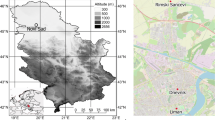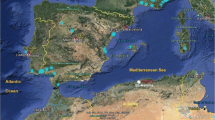Abstract
This paper discuss the problem of forecasting the maximum ozone concentrations in urban microlocations, where reliable alerting of the local population when thresholds have been surpassed is necessary. To improve the forecast, the methodology of integrated models is proposed. The model is based on multilayer perceptron neural networks that use as inputs all available information from QualeAria air-quality model, WRF numerical weather prediction model and onsite measurements of meteorology and air pollution. While air-quality and meteorological models cover large geographical 3-dimensional space, their local resolution is often not satisfactory. On the other hand, empirical methods have the advantage of good local forecasts. In this paper, integrated models are used for improved 1-day-ahead forecasting of the maximum hourly value of ozone within each day for representative locations in Slovenia. The WRF meteorological model is used for forecasting meteorological variables and the QualeAria air-quality model for gas concentrations. Their predictions, together with measurements from ground stations, are used as inputs to a neural network. The model validation results show that integrated models noticeably improve ozone forecasts and provide better alert systems.





Similar content being viewed by others
References
Abonyi J, Madar J, Szeifert F (2002) Combining first principles models and neural networks for generic model control. In: Roy R, Koeppen M, Ovaska S, Furuhashi T, Hoffmann F (eds). Springer London, Soft Computing and Industry, pp 111–122
Al-Alawi SM, Abdul-Wahab SA, Bakheit CS (2008) Combining principal component regression and artificial neural-networks for more accurate predictions of ground-level ozone. Environ Model Softw 23:396–403
Božnar MZ, Lesjak M, Mlakar P (1993) A neural network-based method for short-term predictions of ambient SO2 concentrations in highly polluted industrial areas of complex terrain. Atmos Environ Part B 27 (2):221–230
Božnar MZ, Mlakar P, Grašič B (2012) Short-term fine resolution WRF forecast data validation in complex terrain in Slovenia. Int J Environ Pollut 50(1-4):12–21
Božnar MZ, Mlakar P, Grašič B, Calori G, D’Allura A, Finardi S (2014) Operational background air pollution prediction over Slovenia by QualeAria modelling system—validation. Int J Environ Pollut 54(2-4):175–183
Duarte B, Saraiva PM, Pantelides CC (2004) Combined mechanistic and empirical modelling. Int J Chem React Eng 2(1)
Dudhia J (1989) Numerical study of convection observed during the winter monsoon experiment using a mesoscale Two-Dimensional model. J Atmos Sci 46(20):3077–3107
Dutot AL, Rynkiewicz J, Steiner FE, Rude J (2007) A 24-h forecast of ozone peaks and exceedance levels using neural classifiers and weather predictions. Environ Model Softw 22(9):1261–1269. doi:10.1016/j.envsoft.2006.08.002
EU-Commission (2008) Directive 2008/50/EC of the European Parliament and of the Council of 21 May 2008 on ambient air quality and cleaner air for Europe. Off J Eur Communities 152:1–44
EU-Commission (2011) Commission implementing decision of 12 December 2011, laying down rules for Directives 2004/107/EC and 2008/50/EC of the European Parliament and of the Council as regards the reciprocal exchange of information and reporting on ambient air quality (2011/850/EU). Off J Eur Communities 335:86–106
Google (2016) Google Maps. maps.google.com
Goyal P, Kumar A (2012) Air quality forecasting throught integrated model using air dispersion model and neural network. In: Latest advances in systems science and computational intelligence, WSEAS, WSEAS LLC, pp 219–224
Hong SY, Noh Y, Dudhia J (2006) A new vertical diffusion package with an explicit treatment of entrainment processes. Mon Wea Rev 134(9):2318–2341
Ibarra-Berastegi G, Elias A, Barona A, Saenz J, Ezcurra A, Diaz de Argandona J (2008) From diagnosis to prognosis for forecasting air pollution using neural networks: air pollution monitoring in Bilbao. Environ Model Softw 23(5):622–637
Im U, Bianconi R, Solazzo E, Kioutsioukis I, Badia A, Balzarini A, Bar R, Bellasio R, Brunner D, Chemel C, Curci G, Flemming J, Forkel R, Giordano L, Jimnez-Guerrero P, Hirtl M, Hodzic A, Honzak L, Jorba O, Knote C, Kuenen JJ, Makar PA, Manders-Groot A, Neal L, Prez JL, Pirovano G, Pouliot G, Jose RS, Savage N, Schroder W, Sokhi RS, Syrakov D, Torian A, Tuccella P, Werhahn J, Wolke R, Yahya K, žabkar R, Zhang Y, Zhang J, Hogrefe C, Galmarini S (2015) Evaluation of operational on-line-coupled regional air quality models over Europe and North America in the context of AQMEII phase 2. Atmos Environ Part I: Ozone 115:404–420
Kain JS (2004) The Kain-Fritsch convective parameterization: an update. J Appl Meteorol 43(1):170–181
Kocijan J, Gradišar D, Božnar MZ, Grašič B, Mlakar P (2016) On-line algorithm for ground-level ozone prediction with a mobile station. Atmos Environ 131:326–333
Kukkonen J, Olsson T, Schultz DM, Baklanov A, Klein T, Miranda AI, Monteiro A, Hirtl M, Tarvainen V, Boy M, Peuch VH, Poupkou A, Kioutsioukis I, Finardi S, Sofiev M, Sokhi R, Lehtinen KEJ, Karatzas K, San José R, Astitha M, Kallos G, Schaap M, Reimer E, Jakobs H, Eben K (2012) A review of operational, regional-scale, chemical weather forecasting models in Europe. Atmos Chem Phys 12(1):1–87
Lin YL, Farley RD, Orville HD (1983) Bulk parameterization of the snow field in a cloud model. J Clim Appl Meteorol 22(6):1065–1092. doi:10.1175/1520-0450(1983)022<1065:BPOTSF>2.0.CO;2
Lu WZ, Wang D (2014) Learning machines: rationale and application in ground-level ozone prediction. Appl Soft Comput 24:135–141
MEIS d.o.o. (2016) KOoreg regional air pollution control prognostic and diagnostic modelling system. http://www.kvalitetazraka.si
Mlakar P, Božnar MZ (2011) Advanced air pollution, InTech, Rijeka, chap Artificial neural networks: a useful tool in air pollution and meteorological modelling, 495–508
Mlawer E, Taubman S, Brown P, Iacono M, Clough S (1997) Radiative transfer for inhomogeneous atmosphere: Rrtm, a validated correlated-k model for the longwave
Moustris KP, Nastos PT, Larissi IK, Paliatsos AG (2012) Application of multiple linear regression models and artificial neural networks on the surface ozone forecast in the greater Athens area, Greece. Adv Meteorol 2012:1–8
Pelliccioni A, Tirabassi T (2001) Application of a neural net filter to improve the performances of an air pollution model. In: 7th Int. Conf. on Harmonisation within Atmospheric Dispersion Modelling for Regulatory Purposes, pp 179–182
Pelliccioni A, Tirabassi T (2006) Air dispersion model and neural network: a new perspective for integrated models in the simulation of complex situations. Environ Model Softw 21(4):539–546. doi:10.1016/j.envsoft.2004.07.015
Pelliccioni A, Tirabassi T (2008) Air pollution model and neural network: an integrated modelling system. Il Nuovo Cimento 31(3):253–273
Petelin D, Grancharova A, Kocijan J (2013) Evolving Gaussian process models for the prediction of ozone concentration in the air. Simul Model Pract Theory 33(1):68–80
Skamarock WC, Klemp JB, Dudhia J, Gill DO, Barker M, Duda KG, Huang XY, Wang W, Powers JG (2008) A description of the Advanced Research WRF Version 3. Tech. rep., National Center for Atmospheric Research. doi:10.5065/D68S4MVH
Solaiman TA, Coulibaly P, Kanaroglou P (2008) Ground-level ozone forecasting using data-driven methods. Air Qual Atmos Health 1:179–193
Srl A, ENEA (2016) QualeAria—forecast system for the Air Quality in Italy and Europe. http://www.aria-net.it/qualearia/en/
von Stosch M, Oliveira R, Peres J, de Azevedo SF (2014) Hybrid semi-parametric modeling in process systems engineering: past, present and future. Comput Chem Eng 60:86–101
žabkar R, Honzak L, Skok G, Forkel R, Rakovec J, Ceglar A, žagar N (2015) Evaluation of the high resolution WRF-chem (v3.4.1) air quality forecast and its comparison with statistical ozone predictions. Geosci Model Dev 8(7):2119–2137
Wikimedia (2016) Relief map of Slovenia. https://commons.wikimedia.org
Zanini G, Pignatelli T, Monforti F, Vialetto G, Vitali L, Brusasca G, Calori G, Finardi S, Radice P, Silibello C (2005) The MINNI project: an integrated assessment modeling system for policy making. In: Proceedings of MODSIM05 International Congress on Modelling and Simulation, Melbourne, Australia
Zhang Y, Bocquet M, Mallet V, Seigneur C, Baklanov A (2012) Real-time air quality forecasting, part I: history, techniques, and current status. Atmos Environ 60:632–655. doi:10.1016/j.atmosenv.2012.06.031
Acknowledgments
This work was supported by the Slovenian Research Agency with Grant Development and Implementation of a Method for On-Line Modelling and Forecasting of Air Pollution, L2-5475 and Grant Systems and Control, P2-0001. The Slovenian Environment Agency provided part of the data.
Author information
Authors and Affiliations
Corresponding author
Additional information
Responsible Editor: Marcus Schulz
Appendix A: Performance measures
Appendix A: Performance measures
The following are performance measures used in the study.
-
The root-mean-square error – RMSE:
$$ \text{RMSE} = \sqrt{\frac{1}{N}\sum\limits_{i=1}^{N} (E(\hat{y}_{i})-y_{i})^{2}}, $$(2)where y i and \(\hat {y}_{i}\) are the observation and the prediction in the i-th step, respectively, E(⋅) denotes the expectation, i.e., the mean value, of the random variable, and N is the number of used observations.
-
The standardised mean-squared error – SMSE
$$ \text{SMSE}=\frac{1}{N}\frac{{\sum}_{i=1}^{N}(E(\hat{y}_{i})-y_{i})^{2}}{{\sigma_{y}^{2}}}, $$(3)where \({\sigma _{y}^{2}}\) is the variance of the observations.
-
The Pearson’s correlation coefficient – PCC:
$$ \text{PCC}=\frac{{\sum}_{i=1}^{N}(E(\hat{y}_{i})-E(\hat{\mathbf{y}}))(y_{i}-E(\mathbf{y}))}{N\sigma_{y}\sigma_{\hat{y}}}, $$(4)where \(E(\hat {\mathbf {y}})\) is the expectation, i.e., the mean value, of the vector of predictions, and \(\sigma _{y},\sigma _{\hat {y}}\) are the standard deviations of the observations and the predictions, respectively.
-
The mean fractional bias – MFB:
$$ \text{MFB}=\frac{1}{N}\sum\limits_{i=1}^{N}\frac{E(\hat{y}_{i})-y_{i}}{\frac{1}{2}(E(\hat{y}_{i})+y_{i})}. $$(5) -
The factor of the modelled values within a factor of two of the observations – FAC2:
$$ \mathrm{FAC2}=\frac{1}{N}\sum\limits_{i=1}^{N}n_{i}~~~\text{with}~~~n_{i}= \left\{\begin{array}{ll} 1 & \text{for} ~~0.5\le|\frac{E(\hat{y}_{i})}{y_{i}}|\le 2,\\ 0 & \text{else}. \end{array}\right. $$(6)
RMSE and SMSE are frequently used measures for the accuracy of the predictions’ mean values, which are 0 in the case of perfect model. SMSE is the standardised measure with values between 0 and 1. PCC is a measure of associativity and is not sensitive to bias. Its value is between −1 and +1, with ideally linearly correlated values resulting in a value 1. MFB is the measure that bounds the maximum bias and gives additional weight to underestimations and less weight to overestimations. Its value is between −2 and + 2, with the value 0 in the case of a perfect model. FAC2 indicates the fraction of the data that satisfies the condition from Eq. 6. Its value is between 0 and 1, with the perfect model resulting in a value of 1.
Rights and permissions
About this article
Cite this article
Gradišar, D., Grašič, B., Božnar, M.Z. et al. Improving of local ozone forecasting by integrated models. Environ Sci Pollut Res 23, 18439–18450 (2016). https://doi.org/10.1007/s11356-016-6989-2
Received:
Accepted:
Published:
Issue Date:
DOI: https://doi.org/10.1007/s11356-016-6989-2




